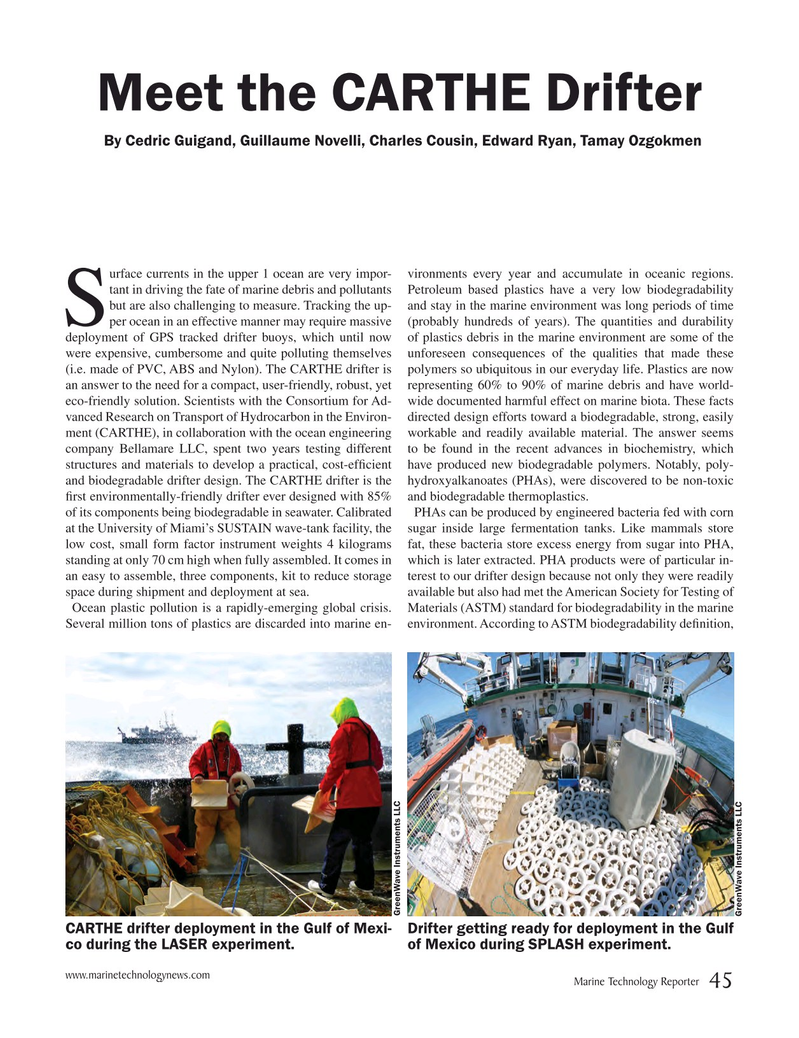
Page 45: of Marine Technology Magazine (September 2017)
Ocean Observation: Gliders, Buoys & Sub-Surface Networks
Read this page in Pdf, Flash or Html5 edition of September 2017 Marine Technology Magazine
Meet the CARTHE Drifter
By Cedric Guigand, Guillaume Novelli, Charles Cousin, Edward Ryan, Tamay Ozgokmen urface currents in the upper 1 ocean are very impor- vironments every year and accumulate in oceanic regions. tant in driving the fate of marine debris and pollutants Petroleum based plastics have a very low biodegradability but are also challenging to measure. Tracking the up- and stay in the marine environment was long periods of time
Sper ocean in an effective manner may require massive (probably hundreds of years). The quantities and durability deployment of GPS tracked drifter buoys, which until now of plastics debris in the marine environment are some of the were expensive, cumbersome and quite polluting themselves unforeseen consequences of the qualities that made these (i.e. made of PVC, ABS and Nylon). The CARTHE drifter is polymers so ubiquitous in our everyday life. Plastics are now an answer to the need for a compact, user-friendly, robust, yet representing 60% to 90% of marine debris and have world- eco-friendly solution. Scientists with the Consortium for Ad- wide documented harmful effect on marine biota. These facts vanced Research on Transport of Hydrocarbon in the Environ- directed design efforts toward a biodegradable, strong, easily ment (CARTHE), in collaboration with the ocean engineering workable and readily available material. The answer seems company Bellamare LLC, spent two years testing different to be found in the recent advances in biochemistry, which structures and materials to develop a practical, cost-ef? cient have produced new biodegradable polymers. Notably, poly- and biodegradable drifter design. The CARTHE drifter is the hydroxyalkanoates (PHAs), were discovered to be non-toxic ? rst environmentally-friendly drifter ever designed with 85% and biodegradable thermoplastics. of its components being biodegradable in seawater. Calibrated PHAs can be produced by engineered bacteria fed with corn at the University of Miami’s SUSTAIN wave-tank facility, the sugar inside large fermentation tanks. Like mammals store low cost, small form factor instrument weights 4 kilograms fat, these bacteria store excess energy from sugar into PHA, standing at only 70 cm high when fully assembled. It comes in which is later extracted. PHA products were of particular in- an easy to assemble, three components, kit to reduce storage terest to our drifter design because not only they were readily space during shipment and deployment at sea. available but also had met the American Society for Testing of
Ocean plastic pollution is a rapidly-emerging global crisis. Materials (ASTM) standard for biodegradability in the marine
Several million tons of plastics are discarded into marine en- environment. According to ASTM biodegradability de? nition,
GreenWave Instruments LLC
GreenWave Instruments LLC
CARTHE drifter deployment in the Gulf of Mexi- Drifter getting ready for deployment in the Gulf co during the LASER experiment. of Mexico during SPLASH experiment.
www.marinetechnologynews.com
Marine Technology Reporter 45
MTR #7 (34-49).indd 45 MTR #7 (34-49).indd 45 8/24/2017 12:49:26 PM8/24/2017 12:49:26 PM

 44
44

 46
46
